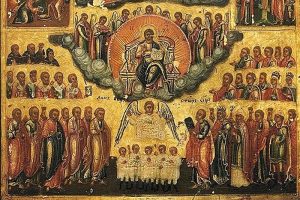Thoughts on Sunday’s Lessons for Nov. 1, 2020
First Reading: Revelation 7:9-17
What a stirring scene we have to begin the readings for All Saints Day, as the Lectionary turns to Revelation from the usual Hebrew Bible first reading.

All the Saints Assembled (c.1850). Detail from the Hexameron, a Russian Orthodox icon. (Click image to enlarge.)
The apocalyptic vision of John of Patmos reveals a countless multitude of people from every race and nation – indeed, all the saints. All the world’s people are gathered to praise the Lamb, Revelation’s allegorical image for Jesus as both sheep and shepherd, both victim and victor, and the loving protector who guides us as a single multitude in all Earth’s glorious diversity.
Psalm: Psalm 34:1-10, 22
Teach us how to pray: Many of the 150 Psalms address God in prayer, but this one is different. These verses from Psalm 34 are imagined as the words of David after he escaped a deadly situation, offering the people wise counsel in the way of prayer: As God’s saints and God’s servants, we should praise and worship God. We are small and humble. God is great and powerful. Yet when we are in trouble, when we are afraid, when we are hungry, we place our faith and trust in God and need not fear. Taste and see that God is good. Happy are we who trust in God!
First Reading: 1 John 3:1-3
The three short letters of John were probably written around the year 100 and not by the hand of the Evangelist we know as John. But they may have come from a community that had followed him. The spirit of these verses from the first letter of John does seem consistent with the theology of John’s Gospel. They celebrate the abundant love of God that showers on us and makes us all God’s children. The glory of our coming adulthood under God’s love remains to be revealed, the author of this letter tells us. But from the beginning, we are assured, all of God’s children, all of God’s saints, are brothers and sisters through God’s creative love.
Gospel: Matthew 5:1-12
When Jesus reveals the Beatitudes in Matthew’s Sermon on the Mount (and in Luke’s similar but intriguingly different version in the Sermon on the Plain), he offers a promise of hope.

The Sermon on the Mount (1598), oil painting on copper by Jan Brueghel the Elder (1568-1625). J. Paul Getty Museum, Los Angeles. (Click image to enlarge.)
This is a promise made in particular to those who are poor, those who mourn, those who are meek, hungry, and thirsty; the merciful, the pure in heart, the peacemakers, the righteous, and the persecuted. “Rejoice and be glad, for your reward is great in heaven,” Jesus tells the multitude. Is Jesus promising a heavenly kingdom, a reward that comes only after we die? Or is he foreseeing a kingdom of heaven on earth, a glorious kingdom that may appear when people begin to live the Beatitudes? If we consider everything that the Gospels teach us about the Way of Jesus, we might hear him calling us to join in building a kingdom that comes on earth as it is in heaven.
